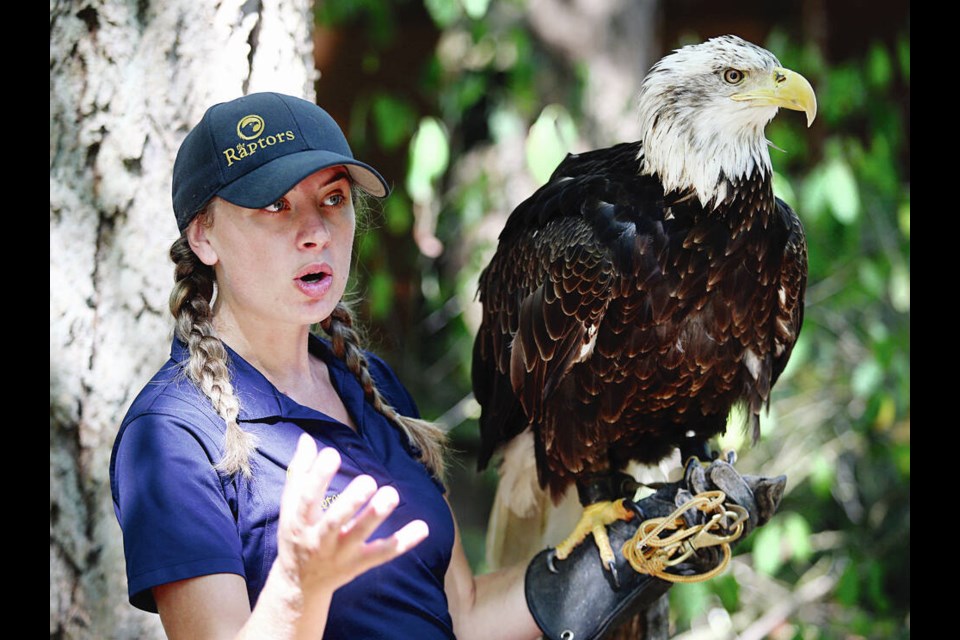t’s the ultimate up close and personal — and hands-on — experience anyone can have with majestic eagles, owls, hawks and falcons.
The Raptors, an educational and tourism facility on an 11-acre spread north of Duncan, is marking its 20th year in operation, captivating visitors with displays of apex predator birds flying, demonstrating their speed, precision, keen eyesight and deadly hunting techniques.
Isaac King, administrator at The Raptors, said a key role of the facility is to educate the public on the birds’ important role in the natural world and to raise awareness of their plight.
He said raptors are declining at an alarming rate in the wild, with 30% of the species at critical thresholds in their populations and currently considered vulnerable, threatened or critically endangered.
Humans are the main reasons, with threats ranging from power-line collisions to secondary poisonings and collisions with vehicles.
“Here we want to get people close and learn about raptors,” said King, adding the goal is to inspire a sense of personal responsibility for the birds and encourage people to share with others what they learn.
Raptors are top predators that help to keep ecosystems in balance, he said. They play an important role in controlling populations of smaller animals.
“They are like a barometer, so when their populations are healthy, the ecosystem is healthy.
The facility has between 120 and 130 birds of prey at any given time, and attracts about 30,000 visitors a year, said King.
There are bald and golden eagles, red-tailed and Harris hawks, five species of falcons, including peregrines, vultures and five species of owls.
There are daily flying demonstrations with eagles, hawks, owls, and vultures, where educators teach visitors about raptor species from around the world, their important ecosystem roles, the threats they face, and how people can help protect them.
It also offers opportunities to interact with raptors. Visitors can take a walk through the woods with a hawk, feel the grip of a falcon on a gloved hand and arm, and meet an inquisitive owl.
There are also summer camps and a week-long falconry course, where you can learn to hunt with a raptor.
Founded by Gillian Radcliffe in 2003, The Raptors also provides wildlife management services across Canada, using the raptors to keep airports clear of bird hazards and controlling the populations of birds such as gulls at landfills.
The company has contracts across Canada and sets up special aviaries so falcons and eagles can do regular patrols of airports targeting species that pose a risk to passenger airplanes.
The Raptors has worked at Vancouver, Saskatoon and Toronto airports and has done consulting and training work closer to home in Nanaimo and Tofino, said King.
He said birds of prey are a quietly effective way of reducing problem species at sites such as airports.
“Gulls, shorebirds, ducks … you don’t want them around airplanes,” said King. “The [falcons] are there to scare them away because you don’t want birds habituating to these areas. It’s a natural process.”
The Raptors facility does not rescue or rehabilitate birds of prey, but does support the Raptors Rescue Society, which has facilities nearby in the Cowichan Valley that are closed to the public.
The society’s non-profit wildlife rehabilitation centre is dedicated to rescuing, rehabilitating and releasing wild raptors and other birds from all over lower Vancouver Island. That includes eagles, hawks, falcons and owls as well as vultures and corvids (crows and ravens). The society’s call line is open seven days a week. Call 778-936-0732.
IF YOU GO:
The Raptors or Pacific Northwest Raptor Centre
Call: 250-746-0372
Where: 1877 Herd Rd. Duncan
Prices and hours: the-raptors.com
>>> To comment on this article, write a letter to the editor: [email protected]



